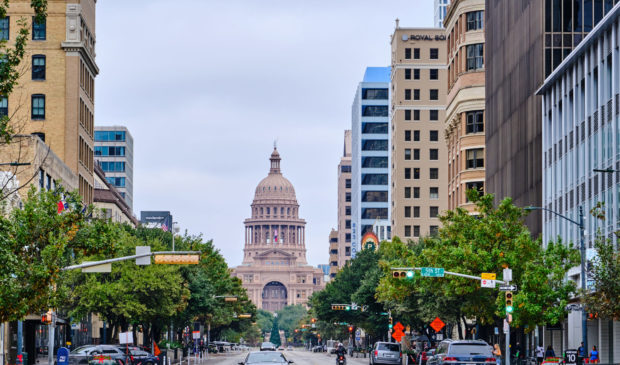Council endorses development bonuses near the Capitol
Friday, May 20, 2022 by
Jonathan Lee A rule prohibiting tall buildings near the Texas Capitol may soon be relaxed, opening up a sleepy part of downtown to more development.
City Council passed a resolution Thursday that would allow properties currently under the Capitol Dominance Overlay – which limits building height within a quarter-mile of the Capitol – to participate in the Downtown Density Bonus Program, thereby granting more height (up to 400 feet for many properties) in exchange for community benefits like money for affordable housing. The resolution passed 10-0 with Council Member Kathie Tovo recused.
“This will incentivize more housing, jobs and other destinations along our busiest transit corridors which will soon host three separate light rail lines,” Council Member Natasha Harper-Madison, who sponsored the resolution, told the Austin Monitor in a statement. “It will absolutely move us towards our mobility, housing and climate goals while also increasing the tax base for vital city services.”
The purpose of the Capitol Dominance Overlay is “to protect the visual and symbolic significance of the state Capitol by keeping buildings in close proximity to the Capitol from dominating the structure.” The rule limits building height by creating an imaginary plane sloping upward at a 24-degree angle from the base of the Capitol dome, keeping maximum heights below approximately 200 feet.
The rule change would not impact Capitol View Corridors, which preserve views of the Capitol from various vantage points via height restrictions.
Developers have increasingly eyed the northern part of downtown for new towers. Pearlstone Partners, for one, plans to build a residential tower at 14th and Lavaca streets. While Pearlstone could build today with the overlay still in place, participating in the density bonus program would allow it to add 72 residential units to the project, bringing the total number of units to 234. The taller project would contribute $1,072,500 toward affordable housing compared to around $70,000 for the shorter project.
The Texas AFL-CIO hopes to take advantage of the change by building affordable housing on its property at 1106 Lavaca St. someday. “We think that given where the building is … that we’re well positioned with respect to transit, access to workplaces, etc. to do a project here,” Rick Levy, president of the Texas AFL-CIO, told Council Thursday.
The Downtown Austin Alliance also wrote in support. “With the addition of Project Connect’s planned light rail and bus rapid transit routes, it is critical to add a denser pattern of transit-oriented development along downtown’s activity corridors,” wrote Dewitt Peart, president and CEO of the nonprofit. “We support code changes that allow for maximum development potential in areas of downtown where density is expected and where sites are already constrained by Capitol View Corridors.”
The code amendment will come back to Council in the coming months for adoption.
Photo made available through a Creative Commons license.
The Austin Monitor’s work is made possible by donations from the community. Though our reporting covers donors from time to time, we are careful to keep business and editorial efforts separate while maintaining transparency. A complete list of donors is available here, and our code of ethics is explained here.
You're a community leader
And we’re honored you look to us for serious, in-depth news. You know a strong community needs local and dedicated watchdog reporting. We’re here for you and that won’t change. Now will you take the powerful next step and support our nonprofit news organization?








